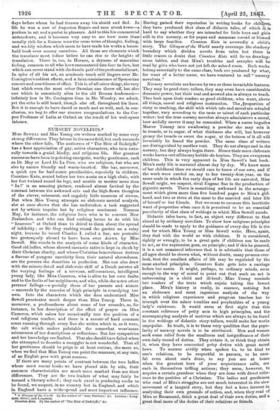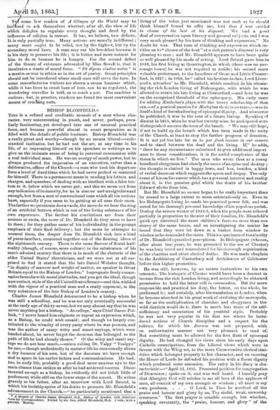NURSERY NOVELISTS.* Miss SEWELL and Miss Young are writers marked
by some very strong differences. They labour in the same field, but each succeeds where the other fails. The authoress of "The Heir of Redclyffe" has a keen appreciation of gay, active characters, who turn natu- rally towards a genial, kindly, and religious life. Her greatest successes have been in painting energetic, worthy gentlemen, such as Dr. May or Lord De La Poer, who are religious, but who are also by nature friendly and warm-hearted. She has, moreover, a quick eye for half-comic peculiarities, especially in children. Countess Kate, seated before her two aunts on a high chair, with her feet twisted round its legs, and unable to mutter more than "In 1" is an amusing picture, rendered almost farcical by the contrast between the awkward acts and the high-flown thoughts of the clever, vehement, and ungainly little countess of eleven. But when Miss Young attempts an elaborate mental analysis, she at once shows that she has undertaken a task suggested not by artistic impulse but by religious sentiment. Norman May, for instance, the religious hero who is to convert New Zealanders, and who can find nothing better to do with his " lionesses " at Oxford than to drivel to them about the spread of infidelity ; or Sir Guy rushing round the garden on a rainy night, because he heard Charles I. called a liar, are portraits too grotesquely absurd to have been ever drawn by Miss Sewell. She excels in the analysis of some kinds of character. Good old ladies, whose shrewd sarcastic satire is kept in check by their Christian charity, and whose Christian benevolence derives a flavour of pungent causticity from their natural shrewdness, are the persons she describes to perfection. She can also draw with the minute detail and elaborate skill of a Dutch painter all the varying feelings of a nervous, self-conscious, intelligent young lady, like Mira Cameron, who is alive to her own faults and to the faults of her neighbours, and who, while she notes other persons' failings —especially those of her parents and sisters — succeeds by the exercise of high principle in remedying her own. Into the characters which she does understand Miss Sewell penetrates much deeper than Miss Young. There is, moreover, a profoundness about some of her remarks, as, for instance, in her description of the effect of prayer on Mira Cameron, which raises her occasionally into the position of a real religious teacher, and there is a savour of hard common sense running through every line she writes which is, as it were, the salt which makes palatable the somewhat wearisome minuteness of her descriptions or reflections. But her sympathies and her knowledge are limited. That she should have failed when she attempted to describe a smuggler is not wonderful. That all her gentlemen should he prigs is at least curious, the more so, 'when we find that Miss Young can paint the manners, at any rate, of an English peer with great success.
If there are many points of contrast between the two ladies whose most recent books we have placed side by side, their common characteristics are much more marked than are their differences. They are the two leaders of what may fairly be termed a literary school ; they each excel in producing works to be found, we suspect, in no country but in England, and which in England have a wide-spread and most important influence.
* 4 Glimpse of the Woad. By the author of" Amy Herbert," de. London : Long- man, Green, and Longman.
Countess Kate. By the author of "The Heir of liedelyfie,"
Having gained their reputation in writing books for chil en, they have produced that class of didactic tales, of which i ' is hard to say whether they are intended for little boys and girls still in the nursery, or for papas and mammas cursed or blessed with large families. Countess Kate is avowedly a child's story. The Glimpse of the World nearly oversteps the shadowy boundary which divides novels from tales, but there is little reason to doubt that Countess Kate will lie on drawing- room tables, and that Mira's troubles and scruples will be read by girls who have not yet left the school-room. Both works belong essentially to the same class, both are produced by what, for want of a better name, we have ventured to call " nursery novelists."
Nursery novelists are known by two or three invariable features. They may be good story-tellers, they may even have considerable dramatic power, but their real and avowed aim is always to teach. They look upon their readers as good children, who want, above all things, moral and religious instruction. The „troportion of story to teaching, the skill with which tale and moral are mingled together, vary according to the taste or talent of each particular writer; but the true nursery novelist always administers a moral, how artfully soever it may be concealed. When a nurse beguiles Master Tommy into swallowing a powder she may mix it in treacle, or in sugar, of what thickness she will, but however greasy the treacle or sweet the sugar, at the bottom of it all will invariably be found the powder. The same class of writers are distinguished by another trait. They do not always end in the nursery, but they always begin there. Hence their more elaborate works have a sort ofliterary hob ble-de-hoyistn. They are overgrown children. This is very apparent in Miss Sewell's last book. Mira's early life is narrated almost day by day. We know more of her childhood than we should care to know of our own, and if the work were carried on, say to her twenty-first year, on the same scale in which the early days of her life are narrated, Miss Sewell might, we suspect, rival Eugene Sue in the production of gigantic novels. There is something awkward in the arrange- ment which gives more than five hundred pages to Mira's girl- hood, and two or three at the most to the married and later life of herself or her friends. But we cease to censure this inartistic want of proportion when once it is perceived to be an essential peculiarity of that class of writings in which Miss Sewell excels.
Didactic tales have, in fact, an object very different to that aimed at by ordinary novelists. To show how religious principles should be made to apply to the guidance of every-day life is the end for which Miss Young or Miss Sewell write. Here, again, they deal with the world as with children. It is considered, rightly or wrongly, to be a great gain if children can be made to act, as the expression goes, on principle; and if this be granted, it is a not unnatural inference that it is advisable that those of all ages should be shown what, without doubt, many persons over- look, that the smallest affairs of life may be regulated by the most exalted principles. Countess Kate gets into a carriage before her aunts. It might, perhaps, to ordinary minds, seem enough in the way of moral to point out that such an act is unbecoming in a child and ill-bred ; Miss Young reminds her readers of the texts which enjoin taking the lowest place. Mira's history is really, in essence, nothing but an elaborate and most ingenious analysis of the way in which religious experience and progress teaches her to triumph over the minor troubles and perplexities of a young lady's existence. It would seem at first sight that this constant reference of petty acts to high principles, and the accompanying analysis of motives which are always to be found in the writings of didactic story-tellers, would make her works unpopular. In truth, it is to these very qualities that the popu- larity of nursery novels is to be attributed. Men and women seek some relief from the smallness and insignificance of their own daily round of duties. They obtain it, or think they obtain it, when they have connected petty duties with great moral laws. To answer civilly when spoken to, to be kind to one's relations, to be respectful to parents, to be care- ful even about one's dress, to say you are at home when the greatest bore of your acquaintance calls, are each in themselves trifling actions; they seem, however, to acquire a certain grandeur when they are done with direct refer- ence to the position of a Christian. The ladies and gentlemen who read of Mira's struggles are not much interested in the slow movement of a languid story, but they feel a keen interest in analyzing their own grounds of action, and, when they read of Mira or Rosamond, think a great deal of their own duties, and s. great deal more of the duties of their relatives or friends. Y some few readers of A Glimpse of the World may be inclined to ask themselves whether, after all, the view of life wSich delights to regulate every thought and deed by the influence of religion is correct. It has, we believe, two defects. It is only partially true. Many actions are morally indifferent ; many more ought to be ruled, not by the highest, but by the secondary moral laws. A man may eat his breakfast because it is 'his duty to preserve his life ; it is better and more natural for him to do so because he is hungry. For the second defect of the theory of existence advocated by Miss Sewell is, that it inculcates a waste of moral force. "Sit dignus vindice nodes" is a maxim as true in ethics as in the art of poetry. Great principles should not be introduced where small ones will serve the turn. In some manufactories visitors are shown a steam hammer which, while it has force to crush bars of iron, can be so regulated, the wondering traveller is told, as to crack a nut. The machine is curious ; amt, in practice, crackers are found the most convenient means of creating nuts.































 Previous page
Previous page